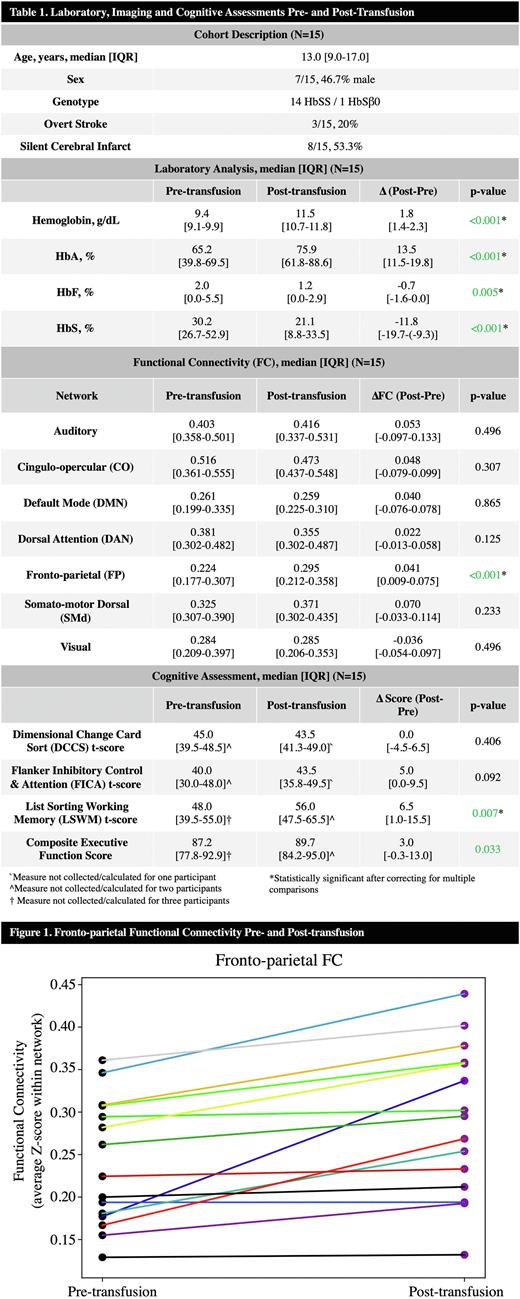Abstract
Introduction Patients with sickle cell anemia (SCA) are at risk for cognitive dysfunction, independent of stroke. Functional connectivity (FC) is a quantitative MR measurement of the interactions between brain regions that compose large-scale networks of activity, giving rise to neurocognitive abilities. Structural connectivity (SC) assesses integrity of white matter axon bundles linking physically distant regions of the brain to allow for interregional interactions. We have shown FC is diminished in patients with SCA compared to healthy controls, and that FC decreases as cerebral metabolic stress, measured by oxygen extraction fraction (OEF, percent of oxygen removed from blood into brain tissue), increases. Paired with evidence that executive function abilities in SCD patients improve as metabolic stress decreases after transfusion of red blood cells (RBCs), we hypothesize that decreasing metabolic stress facilitates the acute reversal of disruptions in FC while SC remains unaffected after a single transfusion in children with SCA.
Methods Patients >5 years of age with SCA receiving chronic transfusion therapy (CTT) (excluding those with cerebral vasculopathy), underwent laboratory evaluation, cognitive testing (NIH Toolbox-Cognition Battery [NIHTB-CB]), and a brain MRI on a Siemens 3T Prisma scanner within 4 days before and after RBC exchange transfusion. Brain MRI measured OEF (asymmetric spin echo [ASE]), FC (resting state BOLD) and SC (diffusion tensor imaging [DTI] with fractional anisotropy [FA] and mean diffusivity [MD] in 16 white matter tracts). OEF and FC processing were previously described (Fields et al. Ann Neurol. 2020; 88(5):995). The BOLD signal was correlated over time between 153 regions in 7 networks. Networks with <5 regions were excluded from analyses (Dworetsky et al. Neuroimage 2021; 237:118164). Global probabilistic tractography was used to reconstruct white matter tracts (Yendiki et al. Front Neuroinform 2011; 5:23). The Dimensional Change Card Sort (DCCS), Flanker Inhibitory Control and Attention (FICA), and List Sorting Working Memory (LSWM) metrics of the NIHTB-CB were averaged to calculate a composite executive function score. Post-transfusion cognitive testing was administered at the participant's first study visit, then pre-transfusion testing 3-7 weeks later, before their next transfusion. The learning effect thus biases our results toward the null (Hood et al. Ped Blood & Cancer. 2019; 66:e27899). Pre- and post-transfusion values were analyzed using the Wilcoxon signed-rank test. Significance threshold was set to α<0.05 after multiple comparison correction using the Benjamini-Hochberg procedure.
Results Data were collected from 15 participants with SCA receiving CTT. Table 1 describes the cohort. There were significant increases in Hb (p<0.001) and HbA (p<0.001), and a decrease in HbS (p<0.001) after transfusion (Table 1). Consistent with prior work, metabolic stress, as measured by OEF, decreased post-transfusion in the whole brain (p=0.005), grey matter (p=0.006) and white matter (p=0.008). There was a significant increase in FC of the fronto-parietal (FP) network post-transfusion after correcting for multiple comparisons (p<0.001, Table 1) without a significant difference in SC of any white matter tracts. The FP network is a higher-level cognitive association network that facilitates executive function abilities. The LSWM test significantly improved post-transfusion (p=0.007) without a significant difference in the DCCS (p=0.406) or FICA (p=0.092) tests with transfusion. After correcting for multiple comparisons, improvement in the composite executive function score post-transfusion was not significant (raw p=0.033).
Conclusion We conclude that there is a decrease in metabolic stress and strengthening of FC within the FP network without a change in SC in children with SCA after receiving a single RBC exchange transfusion. Consistent with the strengthened connectivity within the FP network, we found a significant improvement in executive abilities post-transfusion. These findings suggest MR measures of FC could potentially provide a neuroimaging biomarker for cognitive reversibility in SCA, applicable to emerging therapies in the field.
Disclosures
Fields:Global Blood Therapeutics: Consultancy; Proclara Ciosciences: Other: Equity Ownership.
Author notes
Asterisk with author names denotes non-ASH members.


This feature is available to Subscribers Only
Sign In or Create an Account Close Modal